What are the Hard-headed Dinosaurs Called?
Table of Contents
Pachycephalosaurs are dinosaurs with bony heads, also known as thick-headed lizards. They are an unusual group of herbivorous dinosaurs with a thick-boned dome on top of their skulls. The dome could have been used as decoration or to headbutt other dinosaurs during battle, while other scientists believe it helped attract mates.
Head-butting may appear to be a nasty way for two rivals to settle disputes, but many scientists believe Pachycephalosaurus’ thick skull served another purpose. Modern animals, however, such as American bighorn rams, fight by ramming their heads together. Their horns absorb the impact, protecting their brains from damage. The fortified skull of Pachycephalosaurus may provide additional protection.
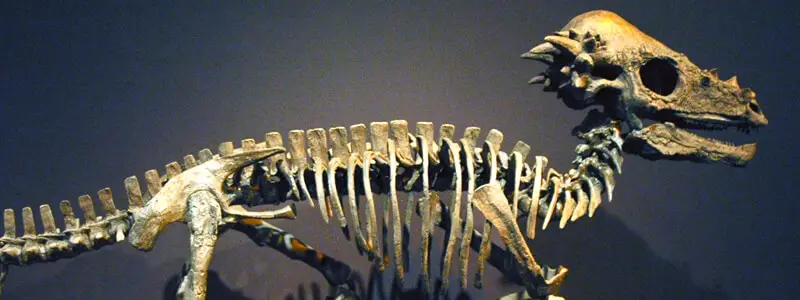
Homalocephale
This pachycephalosauria, or boneheaded dinosaur lived during the Late Cretaceous Period, about 75 million years ago. The boneheads get their name from the thick skulls that they had. It is believed that these skulls might have been used in bunting competitions with rival Homalocephales, or to ram predators, or other threats.
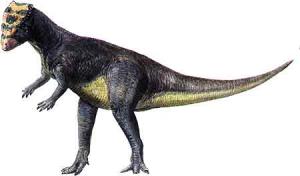 Homalocephale was discovered in Mongolia, and named in 1974 by Teresa Maryanska and Halszka Osmolska. The tail of this smaller dinosaur was very stiff, and appears to have been supported by bony rods. Homalocephale”s head, which was much flatter than other members of the bonehead family, was adorned with a number of bumps or studs, that probably served to decorate its head and attract mates.
Homalocephale was discovered in Mongolia, and named in 1974 by Teresa Maryanska and Halszka Osmolska. The tail of this smaller dinosaur was very stiff, and appears to have been supported by bony rods. Homalocephale”s head, which was much flatter than other members of the bonehead family, was adorned with a number of bumps or studs, that probably served to decorate its head and attract mates.
- What is this dinosaur’s name? Homalocephale
- How do I pronounce it? Hom-ah-low-seff-ah-lee
- What does its name mean? Level Head
- How long was this dinosaur? 9.00 feet, 3.00 meters
- How heavy was this dinosaur? 190.00 pounds
- What class was this dinosaur assigned to? Pachycephalosauria
- What did this dinosaur eat? Plants
- How many years ago did this dinosaur live? 75,000,000 Years Ago
- In what period did this dinosaur live? Late Cretaceous
- Where did this dinosaur live? Asia, Mongolia
Pachycephalosaurus
Pachycephalosaurus was discovered around 1939 by a Montana Rancher named William Winkley. It is to date the largest Pachycephalosaurus or bonehead dinosaur ever discovered. The name bonehead comes from their thick skulls. Pachycephalosaurus” was over 10 inches thick. In many cases, only the thick part of these animals heads have survived to today.
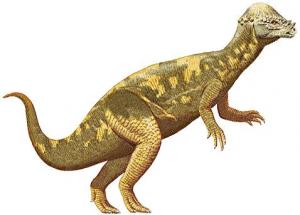 Like other boneheads, Pachycephalosaurus had a dome-shaped head, that may have been used in battle against rival members of its species, or to ram predators. Around this dome where several bump-like studs that were probably used to attract mates. Pachycephalosaurus had very small teeth, that would have not been very useful for eating anything more than soft vegetation such as leafs and fruits.
Like other boneheads, Pachycephalosaurus had a dome-shaped head, that may have been used in battle against rival members of its species, or to ram predators. Around this dome where several bump-like studs that were probably used to attract mates. Pachycephalosaurus had very small teeth, that would have not been very useful for eating anything more than soft vegetation such as leafs and fruits.
- What is this dinosaur’s name? Pachycephalosaurus
- How do I pronounce it? Pack-ee-seff-ah-low-sore-uss
- What does its name mean? Thick-Headed Lizard
- How long was this dinosaur? 16.00 feet, 5.00 meters
- How heavy was this dinosaur? 1100.00 pounds
- What class was this dinosaur assigned to? Pachycephalosauria
- What did this dinosaur eat? Plants
- How many years ago did this dinosaur live? 65,000,000 Years Ago
- In what period did this dinosaur live? Late Creaceous
- Where did this dinosaur live? Montana, North America, South Dakota, Wyoming
Prenocephale
In 1974 Prenocephale was discovered by a team of paleontologist from Russia and Poland. These scientists were digging for fossils in the Gobi Desert.
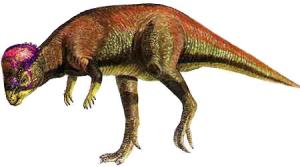 The name Prenocephale means sloped head, which refers to the egg shape of this animals head. Very little is actually known about Prenocephale. Partial skulls, and a few other small bones are all that have been found. For this reason, reconstructions are based largely on one of its close relatives Stegoceras.
The name Prenocephale means sloped head, which refers to the egg shape of this animals head. Very little is actually known about Prenocephale. Partial skulls, and a few other small bones are all that have been found. For this reason, reconstructions are based largely on one of its close relatives Stegoceras.
Prenocephale had very large eyes, which it probably used to detect approaching predators. The brain of Prenocephale was larger than many other dinosaurs. Prenocephale was a member of the Pachycephalosauria, or bonehead dinosaur group. These dinosaurs are often compared to modern sheep, because of their thick skulls. It is thought that these skulls may have been used in head bunting contests.
- What is this dinosaur’s name? Prenocephale
- How do I pronounce it? Pren-owe-seff-ah-lee
- What does its name mean? Sloping Head
- How long was this dinosaur? 8.00 feet, 2.50 meters
- How heavy was this dinosaur? 220.00 pounds
- What class was this dinosaur assigned to? Pachycephalosauria
- What did this dinosaur eat? Plants
- How many years ago did this dinosaur live? 70,000,000 Years Ago
- In what period did this dinosaur live? Late Cretaceous
- Where did this dinosaur live? Alberta, Asia, Montana, North America
Stygimoloch
Discovered in Hell Creek, Montana, and resembling a demon, this dinosaur was named Stygimoloch in 1983. The name Stygimoloch means Styx Demon. The River Styx separated the Earth from Hades in Greek Mythology.
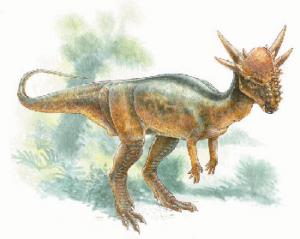 To date, two skulls have been discovered, both showing an abundance of long horns, and studs all over the animals head., Without any direct fossil evidence about its body, Stygimoloch is generally reconstructed based on close relatives such as stegoceras.
To date, two skulls have been discovered, both showing an abundance of long horns, and studs all over the animals head., Without any direct fossil evidence about its body, Stygimoloch is generally reconstructed based on close relatives such as stegoceras.
Stygimoloch was a member of the Pachycephalosauria, or bonehead group of dinosaurs. This name refers to the very thick skulls that may have been used by these animals in head bunting competitions, or to ram predators.
- What is this dinosaur’s name? Stygimoloch
- How do I pronounce it? Stij-ee-moll-ock
- What does its name mean? Styx Demon
- How long was this dinosaur? 9.00 feet, 3.00 meters
- How heavy was this dinosaur? 190.00 pounds
- What class was this dinosaur assigned to? Pachycephalosauria
- What did this dinosaur eat? Plants
- How many years ago did this dinosaur live? 65,000,000 Years Ago
- In what period did this dinosaur live? Late Cretaceous
- Where did this dinosaur live? Montana, North America, Wyoming
Stegoceras
Stegoceras was a member of the pachycephalosauria or bonehead group of dinosaurs. Little is known about this group of dinosaurs, because very few fossils have been found. Most of the fossils that scientists have studied are those of their thick skulls. The boneheaded dinosaurs had very thick skulls indeed. It is believed that they may have been used for bunting contests similar to how sheep and goats bunt each other today.
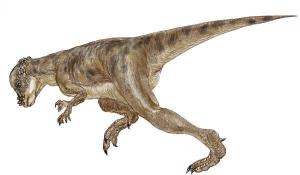 Stegoceras is one of the few boneheads for which there has been discovered more than just a skull. For this reason, many other boneheads are based on what we know about Stegoceras.
Stegoceras is one of the few boneheads for which there has been discovered more than just a skull. For this reason, many other boneheads are based on what we know about Stegoceras.
Stegoceras was discovered in Alberta, Canada in 1902 by Lawrence Lambe. It was about 8 feet long, with powerful back limbs, and weaker front limbs. around the back of its head, Stegoceras had a rim of bone, that resembled what a monarch such as a king or queen might wear today.
- What is this dinosaur’s name? Stegoceras
- How do I pronounce it? Steg-owe-sair-ass
- What does its name mean? Horny Roof
- How long was this dinosaur? 8.00 feet, 2.50 meters
- How heavy was this dinosaur? 150.00 pounds
- What class was this dinosaur assigned to? Pachycephalosauria
- What did this dinosaur eat? Plants
- How many years ago did this dinosaur live? 75,000,000 Years Ago
- In what period did this dinosaur live? Late Cretaceous
- Where did this dinosaur live? Alberta, North America
Yaverlandia
Yaverlandia was discovered in the 1930s on Wight, or Dinosaur Island, England. A very small dinosaur, Yaverlandia is known only from a partial skull fossil.
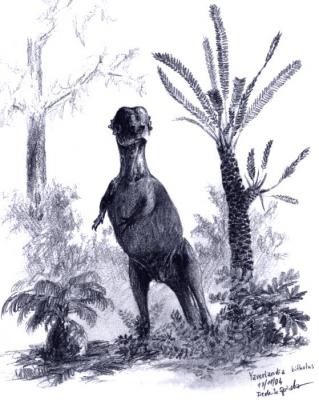 This pachycephalosauria, or boneheaded dinosaur had two distinct lumps or domes on the top of its head. Because of the lack of fossil evidence, we know very little indeed about Yaverlandia.
This pachycephalosauria, or boneheaded dinosaur had two distinct lumps or domes on the top of its head. Because of the lack of fossil evidence, we know very little indeed about Yaverlandia.
- What is this dinosaur’s name? Yaverlandia
- How do I pronounce it? Yav-er-land-ee-ah
- What does its name mean? From Yaverland (Location of Discovery)
- How long was this dinosaur? 40.00 feet, 1.00 meters
- How heavy was this dinosaur? 44.00 pounds
- What class was this dinosaur assigned to? Pachycephalosauria
- What did this dinosaur eat? Plants (Possibly insects)
- How many years ago did this dinosaur live? 125,000,000 Years Ago
- In what period did this dinosaur live? Early Cretaceous
- Where did this dinosaur live? England, Europe
Acrotholus
A new species of bone-headed dinosaur (pachycephalosaur) from Alberta, Canada, has been named by scientists. Acrotholus audeti was discovered in both newly discovered and previously collected fossils. The recently discovered plant-eating dinosaur, which was about six feet long and weighed about 40 kilograms in life, is the oldest bone-headed dinosaur in North America, and possibly the world.
- What is this dinosaur’s name? Acrotholus
- How do I pronounce it? Ack-RHO-tho-LUS
This dinosaur is the latest in a series of new discoveries made by Evans and Ryan as part of their Southern Alberta Dinosaur Project, which seeks to fill gaps in the record and research the evolution of Late Cretaceous dinosaurs. This project focuses on the paleontology of some of Alberta’s oldest dinosaur-bearing rocks, which have received less attention than the well-known badlands of Dinosaur Provincial Park and Drumheller. – sciencedaily.com
